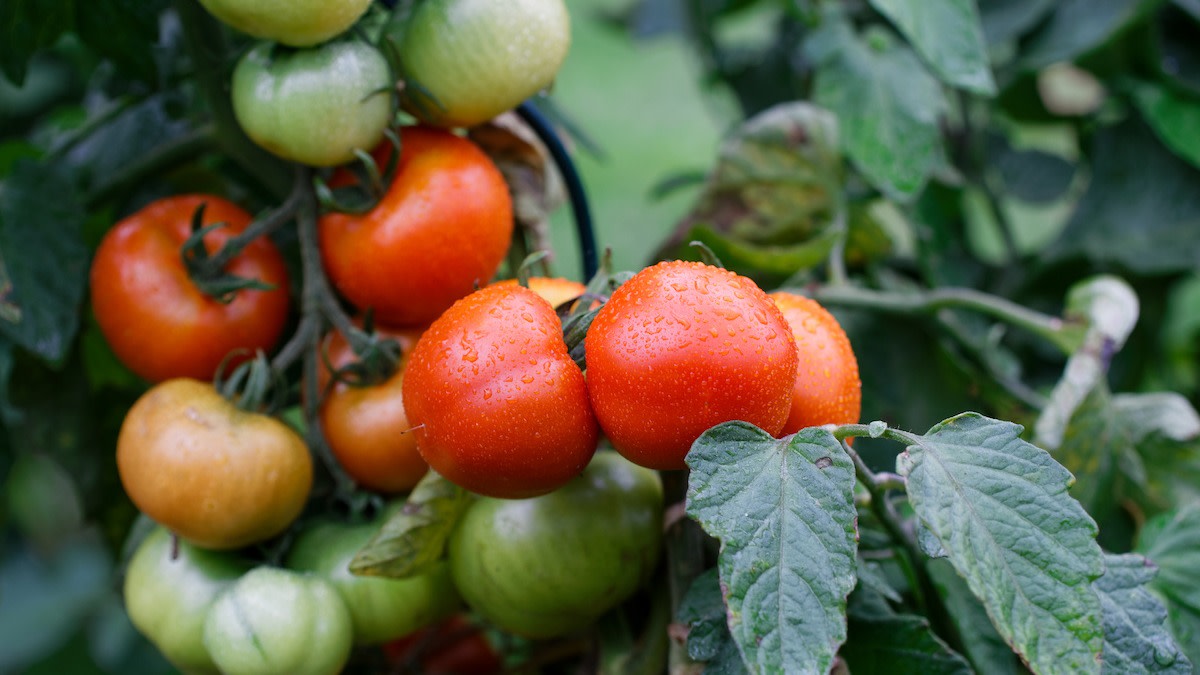Beefsteaks, cherry tomatoes, full-to-bursting heirlooms in tie-dye hues: the endless array of tomato varieties are a centerpiece of any summer vegetable garden. A bountiful tomato crop feels like magic—here’s how to do it.
Learn From the Best
When to Plant Tomatoes
The growing season for tomatoes begins after the last frost in spring, and runs all the way into early fall, depending on temperatures and location. Last frost dates are available per region online or in local grower’s almanacs; start tomatoes along the recommended timeline, after the garden soil temperature has warmed up.
Tomato Planting Varieties
First things first: There are two types of tomatoes— indeterminate tomatoes and determinate tomatoes.
- Indeterminate varieties grow steadily throughout the season, continuing to gain height as they produce fruit along their side shoots. Many heirloom tomatoes like grape and Sun Gold are indeterminate varieties, making for a steady harvest throughout the summer.
- Determinate varieties are typically bushier, and will grow to a “determinate” and predictable size, which makes many of them ideal candidates for potting. Common canning tomatoes like Roma and San Marzanos are of the determinate variety.
While this may not affect planting timing all that much, it may determine the need for tomato cages or trellises. Staking young plants doesn’t just help train the vines in a controlled fashion: it helps to protect the plants from soil-borne diseases and rot, too.
How to Grow Tomatoes
Here’s how to kickstart a homegrown tomato harvest:
- 1. Pick the plants. Tomato transplants can be purchased at a local nursery or gardening store. Look for sturdy stems with vibrant green leaves; skip any with tomatoes already attached. If unsure about how many plants to buy, think about how the fruits will be used. Just for snacking and using in summery tomato tarts or salads? Best to buy one to two plants per person in the household, if you have the garden space. If big batches of sauce or major canning are on the menu, increase the number of plants per person accordingly.
- 2. Check the light in your plot. Most tomato plants thrive in full sun. Although some varieties have been bred to grow in slightly cooler or foggier climates, the best tomatoes are usually the ones that get the full benefit of a sunny spot for at least six hours a day, preferably eight. In particularly hot environments, plants will benefit from intermittent shade to protect from harsh rays. Row covers may be necessary to protect young leaves from drying out.
- 3. Prepare the area with fertilizer and mulch. Before transplanting the tomato seedlings, spread a few pounds of fertilizer per every 100 feet of garden space and mix into the top layers of soil.
- 4. Plant! (Or pot.) Plant tomatoes at least two feet apart, in a hole deep enough to completely cover the root ball and meet the lower leaves. Cover with soil and water well to encourage root development. Potting tomatoes is also an easy way to keep things organized. Plant tomatoes in a pot with plenty of drainage holes, with some organic matter like compost or manure mixed into the potting mix if possible.
- 5. Stake. If staking the plants, gently secure the main stem to a stake with bits of soft string, and remove the suckers—the small side shoots that appear in the space between the main stem and a branch—by pinching or pruning them. Though it’s not a necessary step, this will concentrate nutrients to the two main stems, making for bigger fruit and more manageable plants. If using a wire cage, no need to prune the suckers, as the cage will help to contain a wilder plant.
- 6. Watch, and wait. Planting tomatoes comes with a host of possible setbacks, from blossom end rot to fungal diseases; tomato hornworms, aphids, and whiteflies to late blight. Companion planting with garlic and basil will help deter pests from taking over your tomatoes. Pruning, vigilant weeding, and mulching can help protect and manage plants until it’s time to harvest.
When to Harvest Tomatoes
Depending on the variety, most tomatoes will be ready to harvest 60–70 days after planting, around mid-summer. Ripe tomatoes feel firm and heavy, with taut, deeply colorful skin.
How to Harvest Tomatoes
Harvest tomatoes gently. Apply minimal pressure as you twist the fruit to separate it from the stem. They should detach easily from the stem; if they don’t, leave them for another day or two.
How to Ripen and Store Fresh Tomatoes
Contrary to popular belief, unripe tomatoes won’t ripen faster on a sunny windowsill. Store them stemside-up in a paper bag in a cool spot until they’re ready.
Fresh tomatoes should never be stored in the refrigerator. Keep them on the counter and eat them as close to harvest as possible, to maintain that straight-from-the-garden flavor.
Learn More
Grow your own food with Ron Finley, the self-described "Gangster Gardener." Get the MasterClass Annual Membership and learn how to cultivate fresh herbs and vegetables, keep your house plants alive, and use compost to make your community - and the world - a better place.
